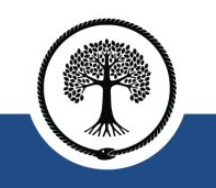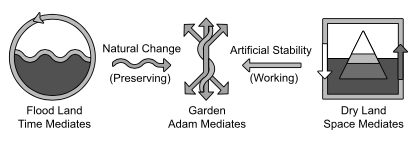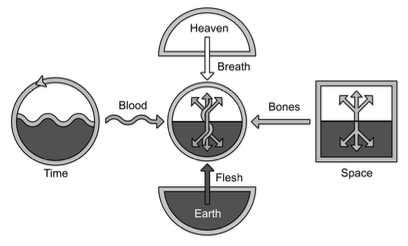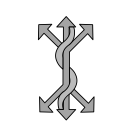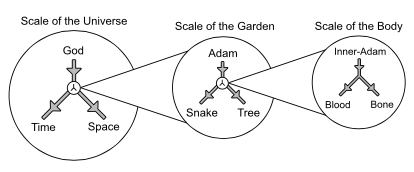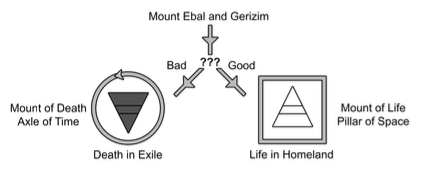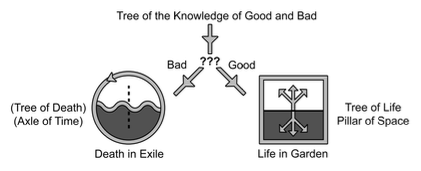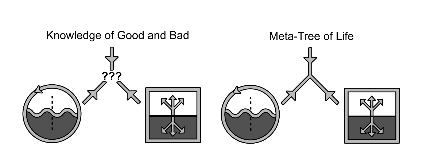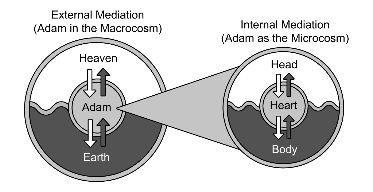The Garden
God planted a garden eastward, in Eden, and there God put the human God had formed
The Garden of Eden is meant to be interpreted as a miniature representation of the cosmos (a microcosm). In this analogy, the Tree of Life 🌳 is a miniature version of the spatial pillar, and the serpent is a miniature version of the time cycle.
Cosmic Prototypes Garden Varieties Universe Garden Heaven Male Earth Female Space Tree Time Snake In ancient cosmology, the cosmic pillar is often symbolized by an enormous tree or mountain, and the waves of the ocean are often associated with a colossal sea serpent. Moreover, the time-cycle itself is depicted as a surrounding snake eating its own tail (a self-negating and self-renewing influence).
Human(s) in the Garden
God took the human and placed him in the Garden of Eden to work it and preserve it
Adam’s job in the Garden is to maintaining this equilibrium by “working and preserving it.” Failing to do so would unleash a cosmic struggle between the formative and transformative forces of the universe. Whenever this happens, the floodwaters begin to confuse, disintegrate, and overturn the land, and the spatial axis pushes back with extreme forces of reason, integration, and stability. At the human scale, this battle usually translates as a war between primitive laws of nature and artificial laws of civilization.
In the context of the Garden of Eden, no such struggle existed because God had bestowed upon humanity the perfect equilibrium of ‘time’ and ‘space.’ Therefore, to maintain this delicate balance, Adam was only required to “work and preserve the Garden.” A small amount of work would counterbalance the irrational excesses of nature, and a minimum of preservation would counterbalance the rational extremes of civilization. Maintaining this equilibrium in the Garden provided Adam with the knowledge of God as creator of heaven, earth, space, and time.
Adam as Microcosm: Blood and Bones
A mist went up from the earth and watered [time] the whole surface of the land. God formed [space] the human from the dust of the ground [earth] and blew into its nostrils the wind of life [heaven]
Adam was described as a microcosm of creation, which means his breath and flesh are miniature representations of heaven and earth. In a similar analogy, the blood and the bones of the human body may be interpreted as microcosms of time and space.
According to these analogies, the blood of Adam is a miniature representation of ‘time’ on the scale of the human body. Like the flood- waters that renew the land, blood is a flowing liquid with restorative powers. So, even though the sight of blood is negative when it signals an injury, it also initiates a healing process that returns the flesh to its initial conditions. Therefore, like water, the function of blood is to “wash” in the sense of refresh and renew. This contrasts with the dry bones, which are the pillars that stabilize and uphold the human body.
In this cosmology, a healthy individual is someone who achieves the perfect knowledge between the breath and the body (heaven and earth), and the perfect balance between the blood and the bones (time and space). Accordingly, one of the most universal symbols of medicine is the Rod of Asclepius, which is composed of a snake coiled around a staff. In the Bible, the snake called “Nehushtan” (a.k.a. “the brass serpent”) is a clear example of this symbolism (see Numbers 21:4-9). Similarly, the familiar image of the “barber’s pole” is composed of a red stripe (blood) coiled around a white pole (bone). These symbols represent a healthy individual and the powers of ancient healers (bloodletting and bonesetting), which used both subtle and rational methods to recover the equilibrium of sick individuals.
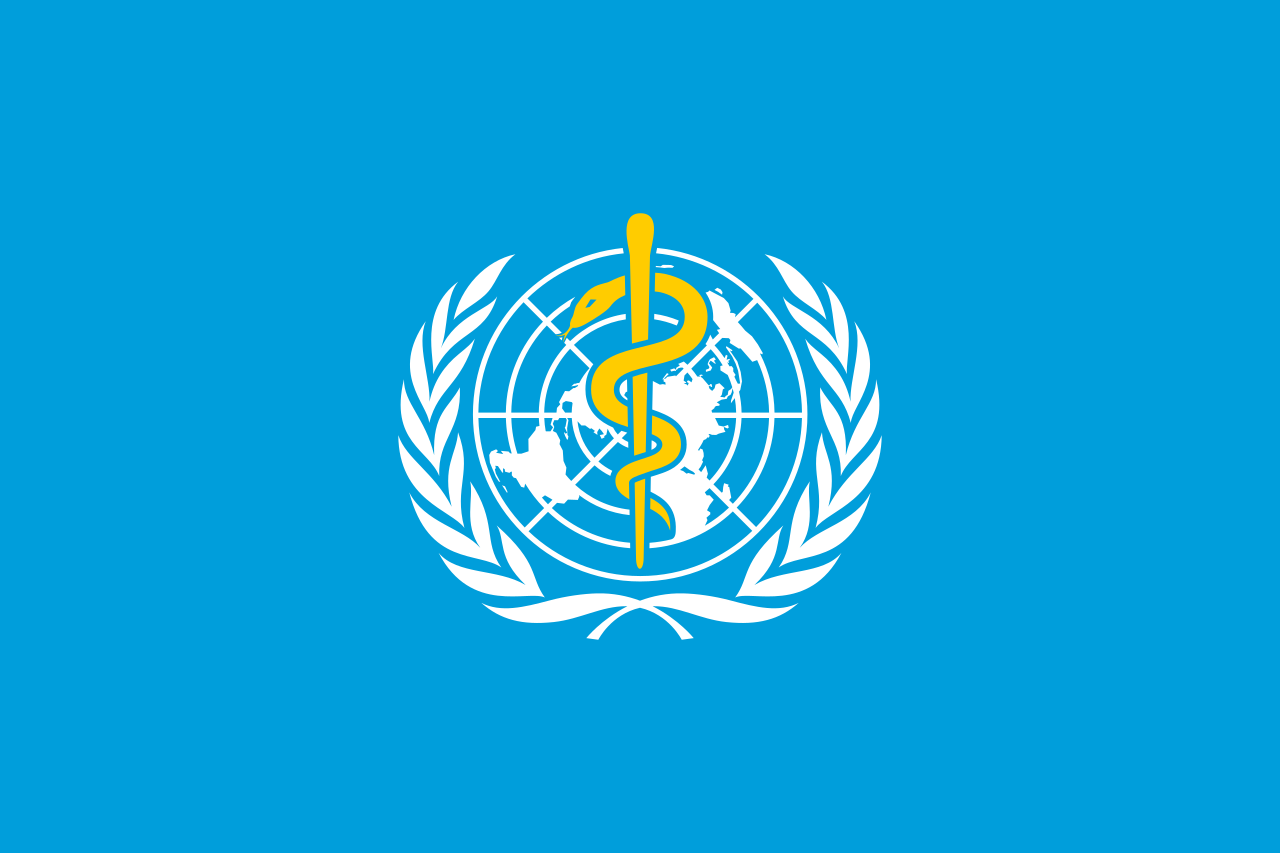 The flag of the World Health Organization, with a rod of Asclepius
The flag of the World Health Organization, with a rod of Asclepius
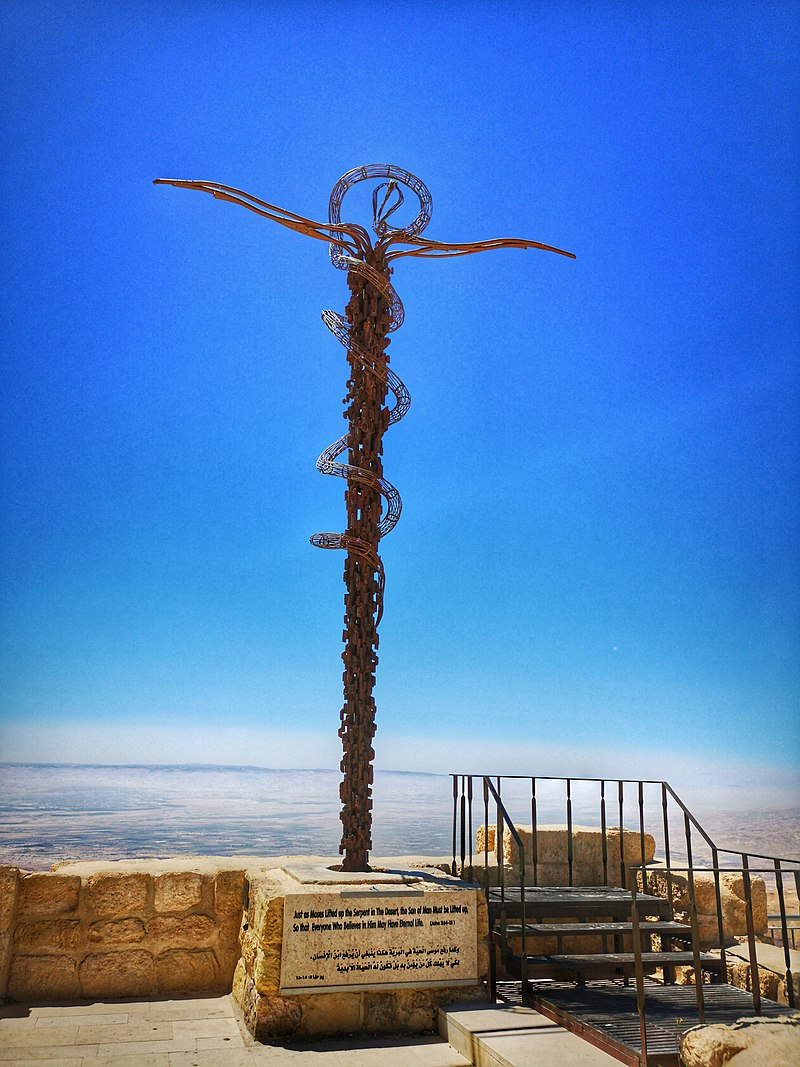 A modern monument of the bronze serpent (which Moses erected in the Negev desert) on Mount Nebo, in front of the church of Saint Moses
A modern monument of the bronze serpent (which Moses erected in the Negev desert) on Mount Nebo, in front of the church of Saint Moses
From the spiritual perspective, creation is perceived as a series of nested microcosms. This pattern implies a miniature version of the whole at the center of the universe. Such imagery is consistent with the notion that God created the universe for knowledge, and that he made a miniature image of himself (Adam) at the center of the world. Similarly, Adam’s purpose in the universe is to create a miniature image of himself (within his “heart”) to mediate between his mind and body (this is certainly the principle behind the homunculus in traditional medicine and folklore).
Because of these analogies, every concept in the language of creation simultaneously describes humanity’s outer and inner worlds. The “outer world” describes Adam as a mediator between heaven and earth, and the “inner world” describes Adam as a mediator between his own mind and body. These concentric worlds are interrelated in biblical cosmology, which means Adam’s actions within himself have implications in the Garden and eventually in the universe.
The Tree(s) of the Garden as Mediator(s) of Knowledge
The Tree of Life 🌳 was in the middle of the garden and the Tree of the Knowledge of Good and Bad (TKGB) 🎄
One of the most puzzling elements in the story of the Garden of Eden is probably the symbolism of the tree of life and the tree of the knowledge of good and bad. At first glance, the narrative implies that these trees are opposites, but there are also suggestions that they are one and the same.
In order to understand the meaning of these trees, it will be useful to compare the tree of the knowledge of good and bad with the patterns of Mount Ebal and Gerizim from Deut. 27-30
I have set before you today life and good, and death and bad … I call heaven and earth to witness against you today, that I have set before you life and death, and the blessing and the curse. Therefore, choose life, that you and your seed may live (Deut. 30:15-19)
As shown in the following diagram, the tree of the knowledge of good and bad is based on the same fundamental pattern as Mount Ebal and Gerizim. The only difference is that the axle of time, or “tree of death,” is not mentioned explicitly in the Garden story. Instead, death and exile are viewed as the natural consequences of losing the tree of life. In other words, the “tree of death” is merely the absence of the “tree of life” in that context.
In biblical cosmology, humanity’s purpose in the universe is to know God as the perfect answer to the riddle of life and death. How- ever, in the story of the Garden of Eden, Adam and Eve were not fully prepared to deal with this paradox at greater scales. Therefore, they were strictly forbidden from eating the fruit of the tree of knowledge.
As shown in the following diagram, the tree of the knowledge of good and bad is itself an unresolved “tree of life.” In other words, the tree of knowledge poses the possibility of transcending “good” versus “bad” with a higher identity. The answer to the riddle is a higher form of Life that transcends regular life. In this case, the tree must no longer be referred to as the “tree of the knowledge of good and bad” because the bad has been transmuted into a higher good.
Ultimately, all the stories in the Bible are about the problem of transmuting the “evil of change” into a higher good that can properly host the Creator of all things.2 Unfortunately, this mysterious operation is risky, because eating from the tree of knowledge without the ability to answer this paradox causes “exile from the garden.”
God exiled the human, and he placed before the Garden of Eden the cherubim and the flaming sword, turning on itself, to keep the way to the tree of life
As a result of these self-similar patterns, the symbolism of the trees in the Garden may be interpreted in a variety of ways. In one sense, the trees are opposites; in another sense, they are part of each other; in yet another sense, they are the same. It all depends on one’s ability to answer the paradox of life and death.
Forbidden Fruit
From the tree of the knowledge of good and bad you must not eat lest you die
According to the story of the Garden of Eden, the original sin committed by humanity was to eat “bad food.” However, it is important to remember that the concept of eating is meant to be interpreted at many different scales within the spiritual worldview. In general, eating is a form of knowledge that involves the integration of matter by a head into its body.
The notion of Sin can be defined from first principles in biblical cosmology because it is a fundamental concept. Simply stated, “sin” is the incorrect union of Heaven and Earth. However, like all words in the language of creation, this can be interpreted on many scales.
In the narrative of the Garden of Eden, the original sin involves disobeying a divine law (failing to support heaven’s breath) which led to eating unsuitable food (failing to integrate earth’s matter). Moreover, it is both a case of incorrectly eating food and incorrectly naming an animal, two actions that are closely related in this cosmology. Thus, Adam was incapable of answering the paradox of the snake (naming that animal) and was then unable to properly ingest the forbidden fruits (integrating food) as recommended by the snake.
Similarly, but on a smaller scale, internal sin is Adam’s failure to properly connect his own mind and body and to reach an agreement between his spiritual and animal components. In other words, sin means inadequately hosting one’s identity within one’s flesh. At the individual level, internal sin means doing something that goes against personal convictions. Similarly, at the communal level, it involves the members of a group going against the laws of their leader.
Healing Medicine
On either side of the river stood a Tree of Life 🌳, bearing twelve kinds of fruit and yielding a fresh crop for each month. And the leaves of the tree are for the healing of the nations
These ancient medical practices are simply the internal versions of Adam’s jobs in the Garden of Eden, who was asked to “preserve and work” the garden to maintain its delicate balance. Of course, it is a mistake to interpret these ancient healing methods with modern medicine, which is based entirely on mechanical causality. Instead, ancient medicine was based on spiritual knowledge and the representation of cosmic influences on different scales. In this context, the powers that healed the individual could also be used to heal an entire community and even the cosmos itself.
Ancient forms of medicine are still practiced today, which sheds considerable doubt on the supremacy of modern medicine. Ironically, that which modern medicine always dismisses as “the placebo effect” is precisely the subtle influence which it is ill-equipped to handle. These are self-referential influences of renewal.
